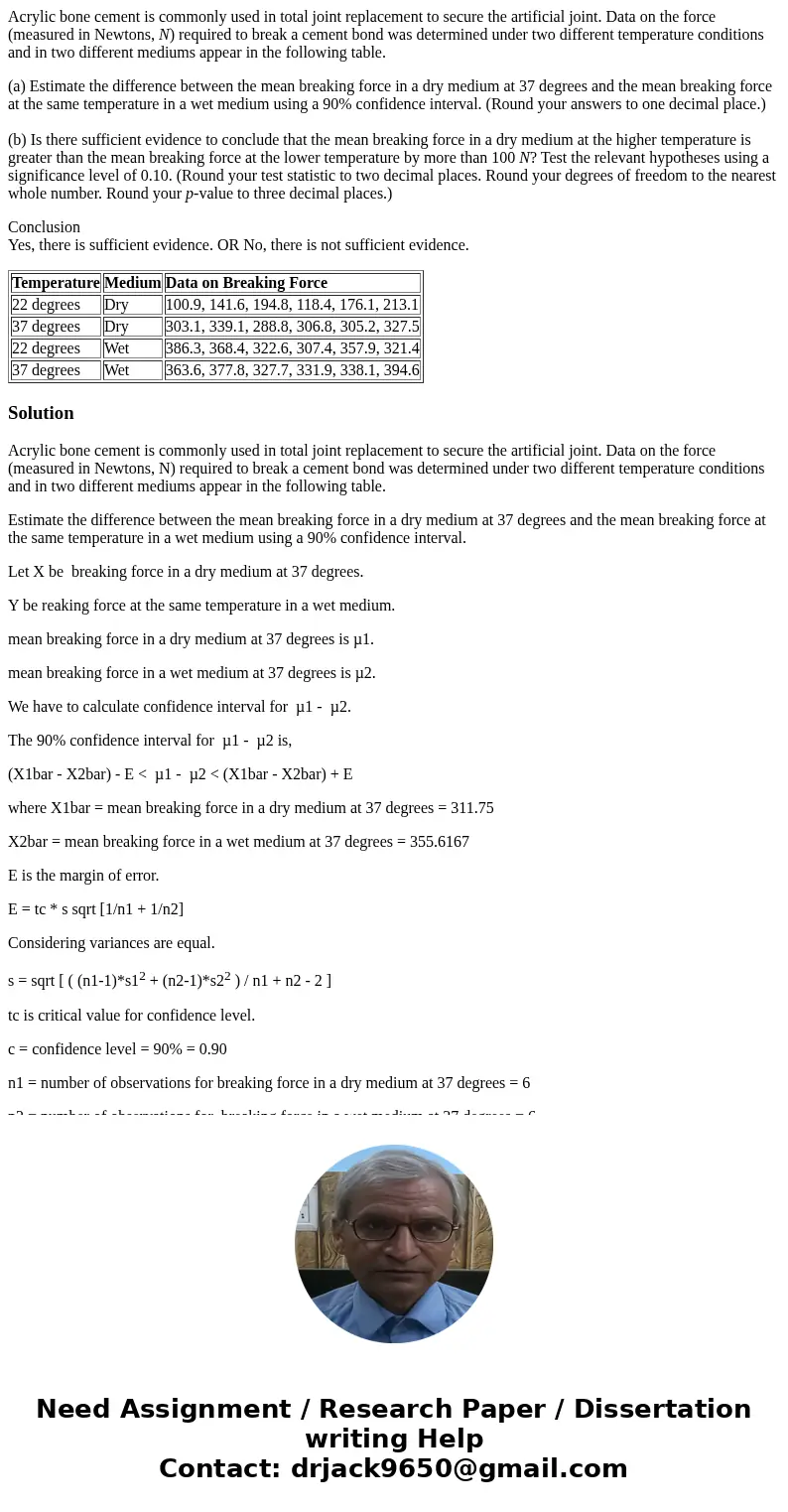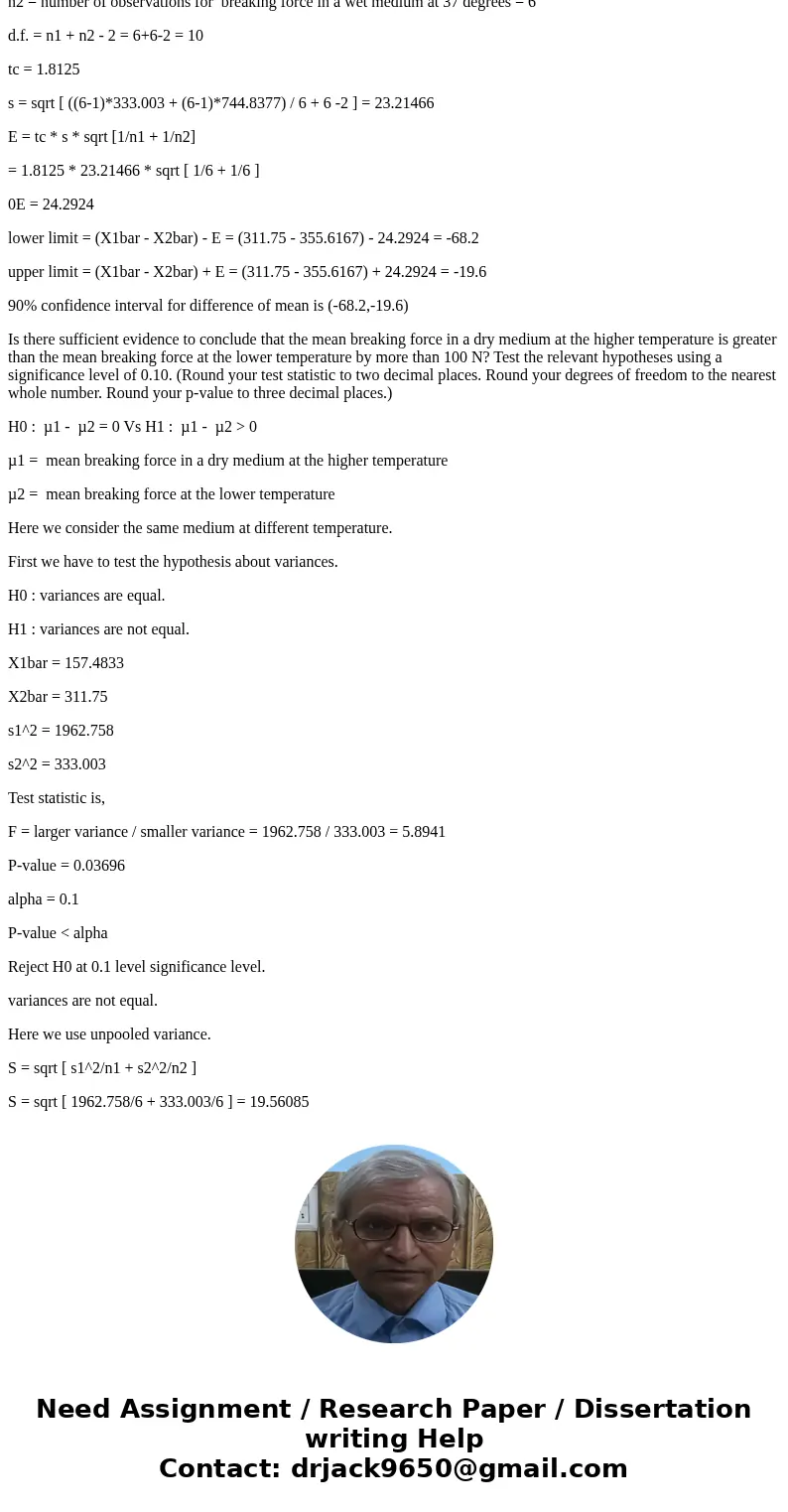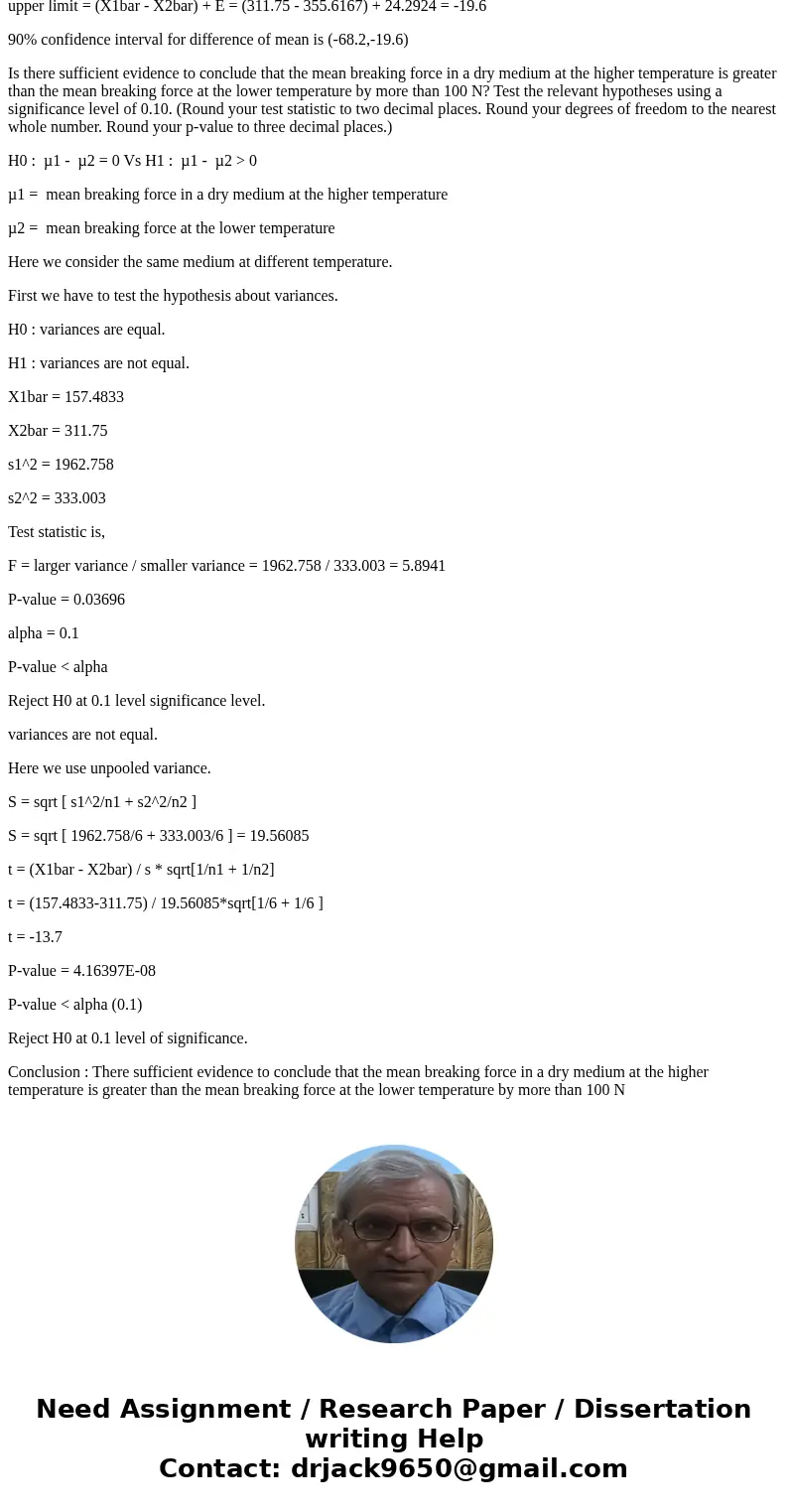Acrylic bone cement is commonly used in total joint replacem
Acrylic bone cement is commonly used in total joint replacement to secure the artificial joint. Data on the force (measured in Newtons, N) required to break a cement bond was determined under two different temperature conditions and in two different mediums appear in the following table.
(a) Estimate the difference between the mean breaking force in a dry medium at 37 degrees and the mean breaking force at the same temperature in a wet medium using a 90% confidence interval. (Round your answers to one decimal place.)
(b) Is there sufficient evidence to conclude that the mean breaking force in a dry medium at the higher temperature is greater than the mean breaking force at the lower temperature by more than 100 N? Test the relevant hypotheses using a significance level of 0.10. (Round your test statistic to two decimal places. Round your degrees of freedom to the nearest whole number. Round your p-value to three decimal places.)
Conclusion
Yes, there is sufficient evidence. OR No, there is not sufficient evidence.
| Temperature | Medium | Data on Breaking Force |
| 22 degrees | Dry | 100.9, 141.6, 194.8, 118.4, 176.1, 213.1 |
| 37 degrees | Dry | 303.1, 339.1, 288.8, 306.8, 305.2, 327.5 |
| 22 degrees | Wet | 386.3, 368.4, 322.6, 307.4, 357.9, 321.4 |
| 37 degrees | Wet | 363.6, 377.8, 327.7, 331.9, 338.1, 394.6 |
Solution
Acrylic bone cement is commonly used in total joint replacement to secure the artificial joint. Data on the force (measured in Newtons, N) required to break a cement bond was determined under two different temperature conditions and in two different mediums appear in the following table.
Estimate the difference between the mean breaking force in a dry medium at 37 degrees and the mean breaking force at the same temperature in a wet medium using a 90% confidence interval.
Let X be breaking force in a dry medium at 37 degrees.
Y be reaking force at the same temperature in a wet medium.
mean breaking force in a dry medium at 37 degrees is µ1.
mean breaking force in a wet medium at 37 degrees is µ2.
We have to calculate confidence interval for µ1 - µ2.
The 90% confidence interval for µ1 - µ2 is,
(X1bar - X2bar) - E < µ1 - µ2 < (X1bar - X2bar) + E
where X1bar = mean breaking force in a dry medium at 37 degrees = 311.75
X2bar = mean breaking force in a wet medium at 37 degrees = 355.6167
E is the margin of error.
E = tc * s sqrt [1/n1 + 1/n2]
Considering variances are equal.
s = sqrt [ ( (n1-1)*s12 + (n2-1)*s22 ) / n1 + n2 - 2 ]
tc is critical value for confidence level.
c = confidence level = 90% = 0.90
n1 = number of observations for breaking force in a dry medium at 37 degrees = 6
n2 = number of observations for breaking force in a wet medium at 37 degrees = 6
d.f. = n1 + n2 - 2 = 6+6-2 = 10
tc = 1.8125
s = sqrt [ ((6-1)*333.003 + (6-1)*744.8377) / 6 + 6 -2 ] = 23.21466
E = tc * s * sqrt [1/n1 + 1/n2]
= 1.8125 * 23.21466 * sqrt [ 1/6 + 1/6 ]
0E = 24.2924
lower limit = (X1bar - X2bar) - E = (311.75 - 355.6167) - 24.2924 = -68.2
upper limit = (X1bar - X2bar) + E = (311.75 - 355.6167) + 24.2924 = -19.6
90% confidence interval for difference of mean is (-68.2,-19.6)
Is there sufficient evidence to conclude that the mean breaking force in a dry medium at the higher temperature is greater than the mean breaking force at the lower temperature by more than 100 N? Test the relevant hypotheses using a significance level of 0.10. (Round your test statistic to two decimal places. Round your degrees of freedom to the nearest whole number. Round your p-value to three decimal places.)
H0 : µ1 - µ2 = 0 Vs H1 : µ1 - µ2 > 0
µ1 = mean breaking force in a dry medium at the higher temperature
µ2 = mean breaking force at the lower temperature
Here we consider the same medium at different temperature.
First we have to test the hypothesis about variances.
H0 : variances are equal.
H1 : variances are not equal.
X1bar = 157.4833
X2bar = 311.75
s1^2 = 1962.758
s2^2 = 333.003
Test statistic is,
F = larger variance / smaller variance = 1962.758 / 333.003 = 5.8941
P-value = 0.03696
alpha = 0.1
P-value < alpha
Reject H0 at 0.1 level significance level.
variances are not equal.
Here we use unpooled variance.
S = sqrt [ s1^2/n1 + s2^2/n2 ]
S = sqrt [ 1962.758/6 + 333.003/6 ] = 19.56085
t = (X1bar - X2bar) / s * sqrt[1/n1 + 1/n2]
t = (157.4833-311.75) / 19.56085*sqrt[1/6 + 1/6 ]
t = -13.7
P-value = 4.16397E-08
P-value < alpha (0.1)
Reject H0 at 0.1 level of significance.
Conclusion : There sufficient evidence to conclude that the mean breaking force in a dry medium at the higher temperature is greater than the mean breaking force at the lower temperature by more than 100 N



 Homework Sourse
Homework Sourse